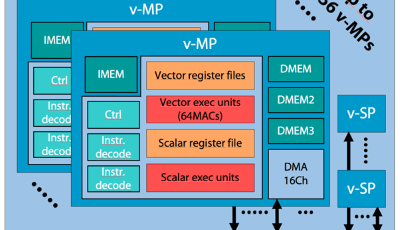New processor and tools for deep learning
March 06, 2018
on
on

videantis GmbH recently announced its new v-MP6000UDX visual processing architecture and v-CNNDesigner tool. The new processor is claimed to increase deep learning algorithm performance by up to three orders of magnitude, while maintaining software compatibility with the already very powerful and successful v-MP4000HDX architecture.
In automotive videantis has seen a lot of growth due to the industry’s rapid adoption of advanced driver assistance systems (ADAS). The technology has been adopted by several leading semiconductor companies and OEMs and is already on the road in millions of vehicles. Another area of growth is in virtual and augmented reality (AR). A recent trend is to bring deep-learning-based algorithms to the embedded vision systems. Deep learning requires orders of magnitude more compute and bandwidth capabilities though, which videantis say it addresses with its new v-MP6000UDX architecture.
The v-MP6000UDX processor architecture includes an extended instruction set optimized for running convolutional neural nets, increases the multiply-accumulate throughput per core eightfold to 64 MACs per core, and extends the number of cores from typically 8 to up to 256. Alongside the new architecture, videantis also announced v-CNNDesigner, a new tool that enables easy porting of neural networks that have been designed and trained using frameworks such as TensorFlow or Caffe. v-CNNDesigner analyses, optimises, and parallelises trained neural networks for efficient processing on the v-MP6000UDX architecture. Using this tool, the task of implementing a neural network is fully automated and it should take mere minutes to get CNNs running on the low power videantis processing architecture.
In automotive videantis has seen a lot of growth due to the industry’s rapid adoption of advanced driver assistance systems (ADAS). The technology has been adopted by several leading semiconductor companies and OEMs and is already on the road in millions of vehicles. Another area of growth is in virtual and augmented reality (AR). A recent trend is to bring deep-learning-based algorithms to the embedded vision systems. Deep learning requires orders of magnitude more compute and bandwidth capabilities though, which videantis say it addresses with its new v-MP6000UDX architecture.
The v-MP6000UDX processor architecture includes an extended instruction set optimized for running convolutional neural nets, increases the multiply-accumulate throughput per core eightfold to 64 MACs per core, and extends the number of cores from typically 8 to up to 256. Alongside the new architecture, videantis also announced v-CNNDesigner, a new tool that enables easy porting of neural networks that have been designed and trained using frameworks such as TensorFlow or Caffe. v-CNNDesigner analyses, optimises, and parallelises trained neural networks for efficient processing on the v-MP6000UDX architecture. Using this tool, the task of implementing a neural network is fully automated and it should take mere minutes to get CNNs running on the low power videantis processing architecture.
Read full article
Hide full article


Discussion (0 comments)